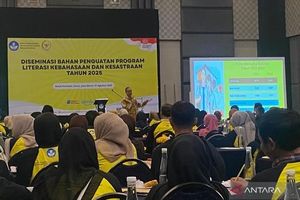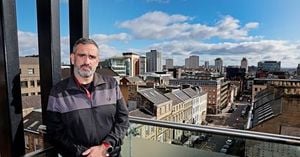On the evening of August 29, 2025, a quiet stretch of 9th Avenue South in St. Petersburg, Florida, became the unexpected stage for a protest that would quickly draw statewide attention. As the sun set outside the Carter G. Woodson African American Museum, two local pastors—Rev. Andy Oliver of Allendale United Methodist Church and Rev. Benedict Atherton-Zeman of the Unitarian Universalist Church of St. Petersburg—sat down on the brightly painted asphalt, refusing to move as Florida Department of Transportation (FDOT) workers prepared to erase the “Black History Matters” street mural. Their peaceful act of civil disobedience led to their arrest by St. Petersburg police, but the reverberations of their protest have continued to echo far beyond the city’s borders.
According to Axios, the pastors’ actions came in direct response to a statewide directive ordering the removal of street murals, which Florida officials have cited as safety concerns. The “Black History Matters” mural, originally painted in 2020 by local artists and later modified in 2023, had become a symbol of community pride and remembrance. Located on a dead-end street with minimal car traffic, the mural sat just outside the Woodson Museum, itself named for the pioneering African American historian Carter G. Woodson, who is widely credited as the founder of Black History Month.
Police reports and statements from the St. Petersburg Police Department confirm that around 8:15 p.m., Rev. Oliver, 45, and Minister Atherton-Zeman, 59, walked past officers, knelt, and sat down on the mural, praying in the roadway. Despite repeated warnings to move, both men refused, leading officers to arrest them on charges of misdemeanor obstruction and hindering traffic. Jail records show the pastors were booked into the Pinellas County jail that night and released early the next morning after each posted $500 bail. Their arrest was not the only drama of the evening: as the FDOT crews worked through the night, the mural was covered by fresh black paint, and by sunrise on August 30, 2025, the “Black History Matters” message had been erased from the street outside the museum.
Rev. Oliver did not let the moment pass quietly. Early Saturday, he took to Facebook, writing, “Black history still matters… if you look hard at the picture, you can see that even Ron’s paint couldn’t fully hide that truth. Carter G. Woodson’s words echo to us in this moment: ‘Let us banish fear… I am a radical. I am ready to act, if I can find brave [people] to help me.’” The quote, drawn from a 1915 letter by Woodson, was a pointed reminder of the enduring struggle for civil rights and the importance of preserving Black history even in the face of official opposition.
This mural was just one of several targeted for removal in St. Petersburg as part of Florida’s broader campaign against pavement art. The Tampa Bay Times reported that by the end of August, four out of five of the city’s prominent street murals had been covered by the state. The only remaining artwork was the Pride Progressive mural, a colorful intersection in the Grand Central district. Other murals removed included the “Fluid Structures” mural at the University of South Florida St. Pete campus, which depicted a marine ecosystem through geometric shapes, and a geometric mural in the Child’s Park neighborhood designed to improve pedestrian safety. According to St. Petersburg Mayor Ken Welch, the “Common Ground” mural in downtown St. Pete had even contributed to a 70% reduction in traffic accidents at its intersection.
The state’s rationale for the removals—citing safety and uniformity on roadways—has not gone unchallenged. The FDOT’s directive, issued under the administration of Governor Ron DeSantis, argued that streets should not serve as canvases for political or ideological messages. DeSantis ordered that all such murals be removed by September 4, 2025, a mandate that has been enforced across Florida, including the painting over of Orlando’s rainbow crosswalk honoring Pulse nightclub shooting victims and Daytona’s checkered crosswalk. According to WUSF, DeSantis stated, “Streets should not be used for political or ideological messages.”
Yet, the removal of these murals has sparked both local and statewide debate. Mayor Welch, speaking to reporters, acknowledged the city’s limited power to resist the state’s order. “As Mayor of our city, I will not risk these essential investments in a fight that I don’t believe we can win,” he said, as reported by Florida Politics. “That would be irresponsible leadership and detrimental to our city in the long run.” Welch urged residents to “obey the law” and not “take the bait” by engaging in direct confrontation, but he also hinted at the possibility of “good trouble,” echoing the late Civil Rights leader John Lewis. When pressed for specifics, Welch replied, “when we build back better and stronger.”
The incident in St. Petersburg is just the latest flashpoint in a larger national conversation about public art, free speech, and the preservation of Black history. The Woodson Museum, outside of which the mural once stood, is itself a testament to the ongoing effort to recognize and celebrate African American contributions to American life. Carter G. Woodson’s legacy, preserved not only in the museum but also in the annual observance of Black History Month, continues to inspire activists and community leaders alike.
Across Florida, reactions to the mural removals have been varied. Supporters of the state’s position argue that traffic safety and the uniform application of transportation laws must take precedence over artistic or political expression on public roads. Some residents have expressed concern that street murals, no matter how well-intentioned, could distract drivers or create confusion at intersections. Others, however, see the removals as part of a broader pattern of erasing minority voices and curbing freedom of expression in public spaces. For many in St. Petersburg’s Black community, the loss of the “Black History Matters” mural feels especially poignant, given the mural’s proximity to the Woodson Museum and its role as a visible affirmation of Black pride and resilience.
In the days following their arrest, both Rev. Oliver and Minister Atherton-Zeman returned to the site of the former mural, continuing to advocate for the preservation of Black history and the importance of community storytelling. Oliver’s call to action—urging supporters to donate to the museum and share stories of Black history—underscores a determination to keep these narratives alive, even as the physical markers are scrubbed from the city’s streets.
As Florida’s deadline for mural removal passes, the fate of street art in St. Petersburg and beyond remains uncertain. While the state’s position on road safety is unlikely to change soon, the outpouring of local support for the pastors and the Woodson Museum suggests that the underlying issues—representation, remembrance, and resistance—are far from resolved. For now, the story of the “Black History Matters” mural stands as a vivid reminder of the ongoing dialogue between art, activism, and authority in America’s public spaces.






